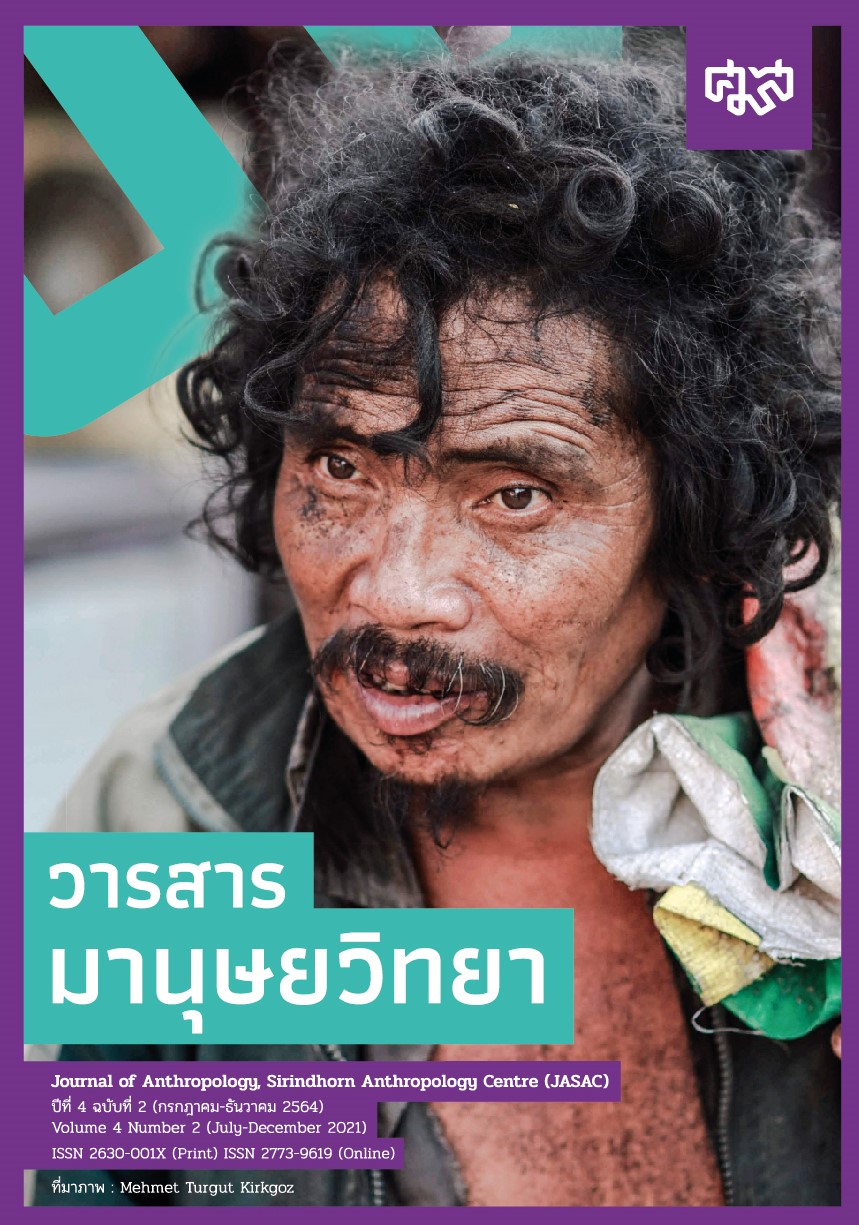พิพิธบางลำพูกับแฟนตาซีชาตินิยม การสร้างการรับรู้และอารมณ์ความรู้สึก
Main Article Content
บทคัดย่อ
วัตถุประสงค์หลักของการจัดตั้งพิพิธบางลำพูคือความต้องการในการอนุรักษ์และนำเสนอความหลากหลายทางวัฒนธรรมของพื้นที่บางลำพู อย่างไรก็ตาม เมื่อพิจารณาการจัดแสดงภายในพิพิธดังกล่าวแล้วกลับพบว่าพิพิธบางลำพูเลือกนำเสนอเฉพาะประวัติศาสตร์อันดีงามของชาติ อันนำไปสู่อารมณ์ความรู้สึกภาคภูมิใจในชาติ บทความชิ้นนี้จึงมีวัตถุประสงค์เพื่อศึกษาการจัดแสดงความเป็นชาติในพิพิธภัณฑ์ โดยใช้กรณีศึกษาพิพิธบางลำพูภายใต้คำถามวิจัย 2 ข้อ ได้แก่ 1) พิพิธบางลำพูมีการเลือกและไม่เลือกนำเสนอชีวิตวัฒนธรรมในชุมชนบางลำพูอย่างไร และ 2) พิพิธบางลำพูเป็นส่วนหนึ่งของการสร้างความรู้ในการประกอบสร้างความเป็นชาติอย่างไร ผลการศึกษาชี้ให้เห็นว่าการร่วมก่อร่างสร้างชาตินิยมของพิพิธบางลำพูถูกประกอบขึ้นจาก 2 องค์ประกอบสำคัญคือ 1) องค์ความรู้ที่ถูกเลือกนำเสนอภายในพิพิธบางลำพู ได้แก่ ข้อมูลสีสันบางลำพูบอกเล่าประวัติความเป็นมาของชุมชนของดีบางลำพู และถิ่นคนดีศรีบางลำพู เป็นต้น ในส่วนนี้ชี้ให้เห็นว่าองค์ความรู้ที่ถูกนำเสนอเป็นเรื่องเล่าของชาติในแบบอุดมคติที่รัฐต้องการ เฉกเช่นเดียวกับนิยามของคำว่าวัฒนธรรม คือสิ่งดีงามและสิ่งอันเจริญงอกงามของประเทศ อย่างไรก็ตามเมื่อศึกษาประวัติบางลำพูโดยการสัมภาษณ์เชิงลึกจากคนในชุมชน กลับพบว่ามีประวัติศาสตร์ที่ไม่ถูกเลือกให้นำเสนอในพิพิธบางลำพูอีก หลายสิ่งซึ่งเป็นภาพในทางลบ อาทิ การค้าฝิ่นและศึกสิบสามห้าง เป็นต้น และ 2) อารมณ์ความรู้สึกที่ถูกเร้า กล่าวคือ ข้อมูลที่ถูกนำเสนอถูกแต่งเติมจินตภาพด้วยเทคนิคต่าง ๆ เมื่อเข้าไปในพิพิธบางลำพูผู้ชมจะได้รับกลิ่นอายจากภาพ แสง สี และเสียง (จำลอง) ถึงสภาพบางลำพูในประวัติศาสตร์ตามจินตภาพ อันประกอบสร้างให้เกิดความรู้สึกโหยหาอดีตและการนึกหวนถึงชาติในจินตนาการ ดังนั้นพิพิธบางลำพูจึงมิใช่พิพิธ (ภัณฑ์) ที่นำเสนอประวัติชุมชนบางลำพู แต่เป็นส่วนหนึ่งของการร่วมสร้างจินตภาพแบบชาตินิยม
Article Details

อนุญาตภายใต้เงื่อนไข Creative Commons Attribution-NonCommercial-NoDerivatives 4.0 International License.
ลิขสิทธิ์@ของวารสารมานุษยวิทยา
ศูนย์มานุษยวิทยาสิรินธร (องค์การมหาชน), กรุงเทพฯ, ประเทศไทย
ข้อมูลเพิ่มเติม:
https://creativecommons.org/licenses/by-nc-nd/4.0/
เอกสารอ้างอิง
จุลจักพงษ์, พระเจ้าวรวงศ์เธอ พระองค์เจ้า. (2554). เจ้าชีวิตพงศาวดาร 9 รัชกาลแห่งราชวงศ์จักรี. กรุงเทพฯ: สำนักพิมพ์ริเวอร์บุ๊คส์จำกัด.
ตรงใจ หุตางกูร. (2554). “ความหมายสากลของพิพิธภัณฑ์ และพัฒนาการของ "พิพิธภัณฑ์แห่งกรุงสยาม”” [ออนไลน์]. เข้าถึงได้จาก : คลังความรู้ พิพิธภัณฑสถานแห่งชาติ อินทร์บุรี. website: http://www.finearts.go.th/inburimuseum/parameters/km/item/ความหมายสากลของพิพิธภัณฑ์ สืบค้น 8 กันยายน 2562.
ชีวสิทธิ์ บุณยเกียรติ. (2562). “การก่อรูปและการเปลี่ยนแปลงความหมายของพิพิธภัณฑสถานกรณีศึกษาพิพิธภัณฑ์สถานแห่งชาติสิงคโปร์จากยุคอาณานิคมสู่การสร้างชาติ”. วารสารสังคมวิทยามานุษยวิทยา มหาวิทยาลัยธรรมศาสตร์, 38(1): 51-81.
ชุติมา ประกาศวุฒิสาร. (2562ก). “จินตภาพของการสูญเสียกับการสร้างชุมชนแบบแอฟเฟ็คท์ กรณีศึกษาทวิภพของทมยันตีและกลุ่มพันธมิตรฯ กู้ชาติ”, ใน ไชยรัตน์ เจริญสินโอฬาร (บก.), หน้า 3-56, การสร้างการรับรู้ในสังคมไทยเล่ม 1 อารมณ์ ความรู้สึกนึกคิด แอฟเฟ็คท์. กรุงเทพฯ: สำนักงานกองทุนสนับสนุนงานวิจัย (สกว).
ชุติมา ประกาศวุฒิสาร. (2562ข). “การเมืองกับการสร้างโลกแฟนตาซีของความสุขในสังคมไทย”, ใน ไชยรัตน์ เจริญสินโอฬาร (บก.), หน้า 3-56, การสร้างการรับรู้ในสังคมไทยเล่ม 2 อารมณ์ ความรู้สึกนึกคิด แอฟเฟ็คท์. กรุงเทพฯ: สำนักงานกองทุนสนับสนุนงานวิจัย (สกว).
ทวีศักดิ์ หว่างจันทร์. (2558). “ศิลปะการแทงหยวกกล้วย” [ออนไลน์]. เข้าถึงได้จาก: https://www.stou.ac.th/study/sumrit/7-58/page2-7-58.html สืบค้น 5 กันยายน 2562
นวภู แช่ตั้ง. (2562). “ปรากฏการณ์วิทยาของพิพิธภัณฑ์: ข้อเสนอเชิงทฤษฏีว่าด้วยภววิทยาของการจัดแสดงภววิทยาของการจัดแสดง”. วารสารสังคมวิทยามานุษยวิทยา มหาวิทยาลัยธรรมศาสตร์, 38(1): 29-49.
นิติ ภวัตรพันธุ์. (2558). ชวนถกชาติและชาติพันธุ์ ข้อถกเถียงว่าด้วย ‘ชาติ’และ’ชาติพันธุ์’. กรุงเทพฯ: สยามปริทัศน์.
ปริทรรศน์. (2552). “ย้อนตำนานซ่องไทย ธุรกิจสีเทาในเงามืด” [ออนไลน์]. เข้าถึงได้จาก : ผู้จัดการรายวัน. web site: https://talk.mthai.com/inbox/48288.html สืบค้น 5 กันยายน 2562
พิเชฐ สายพันธ์ และคณะ. (2542). รายงานโครงการวิจัยชุมชนศึกษา(Community Study)เรื่องจินตภาพบางลำพู (เอกสารทางวิชาการ หมายเลข ไม่ปรากฏ). กรุงเทพมหานคร:สถาบันไทยคดีศึกษา มหาวิทยาลัยธรรมศาสตร์.
มิวเซียมไทยแลนด์ [ออนไลน์]. (2562). เข้าถึงได้จาก: https://www.museumthailand.com/th/museum/Pipit-Banglamphu-Museum สืบค้น 5 กันยายน 2562
ลุงถนอม. (2562, กรกฏาคม 26 ). ผู้ดูแลชุมชนวัดสังเวช. สัมภาษณ์.
วนิดา วารีเศวตสุวรรณ. (2558). “มรดกภูมิปัญญาทางวัฒนธรรมของชาติประจำปี 2557” [ออนไลน์]. เข้าถึงได้จาก : http://203.131.219.167/km2559/2015/03/30/%E0%B8%A1%E0%B8%A3%E0%B8%94%E0%B8%81%E0%B8%A0%E0%B8%B9%E0%B8%A1%E0%B8%B4%E0%B8%9B%E0%B8%B1%E0%B8%8D%E0%B8%8D%E0%B8%B2%E0%B8%97%E0%B8%B2%E0%B8%87%E0%B8%A7%E0%B8%B1%E0%B8%92%E0%B8%99%E0%B8%98%E0%B8%A3 . สืบค้น 30 มีนาคม 2558
วิมลสิริ เหมทานนท์. (2546). การมีส่วนร่วมของชุมชนในการอนุรักษ์ทรัพยากรการท่องเที่ยว : ศึกษากรณีชุมชนย่านบางลำพู. วิทยานิพนธ์ สังคมวิทยามหาบัณฑิต (สค.ม.) จุฬาลงกรณ์มหาวิทยาลัย.
สุภาภรณ์ จินดามณีโรจน์ และคณะ. (2554). ประวัติศาสตร์ท้องถิ่นย่านเก่าในกรุงเทพมหานคร. กรุงเทพฯ : คณะโบราณคดี มหาวิทยาลัยศิลปากร, 2554.
สมปอง ดวงไสว. (2552). บางลำพูวิทยา. กรุงเทพฯ: สำนักพิมพ์สมปอง.
Višnja Kisić. (2017). “Museums, Neutrality and “All the Other Stuff””, International Council of Museums Magazine, No.6: 6-7.


